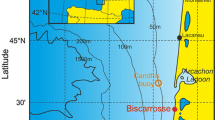Abstract
Considering the diversity of rip currents based on the classification of Castelle et al. (2016), it is crucial to study the characteristics of each individual rip current type, which are classified based on different dominant controlling forces and physical driving mechanisms. In this study, an analytical model was presented to predict the spacing of channel rip currents \((S_{\mathrm{rip}})\) in intermediate beaches using the equations of continuity and momentum. Then, the analytical model predictions were compared with the results of numerical simulations calibrated with field studies of other researchers, that showed good agreements. The main results of this study showed that rip spacing was simultaneously related to the characteristics of wave and bed in the surf zone. In addition, it was shown that due to inevitable changes of the hydrodynamic and morphological conditions of rip channel in the beach, the parameter \(H_{b0}/h_{c}\) (where \(H_{b0}\) is the wave height before approaching the sand bar and \(h_{c}\) is channel depth) is an important factor in predicting the rip current situation and the changes of the beach state with time.









Similar content being viewed by others
References
Battjes J A and Janssen J P F M 1978 Energy loss and set-up due to breaking of random waves; Proc. 16th Int. Conf. Coastal Engineering, ASCE, pp. 569–587.
Bowen A J 1969 Rip currents 1: Theoretical investigations; J. Geophys. Res. 74 5438–5478.
Bowen A J and Inman D L 1969 Rip currents 2: Laboratory and field observations; J. Geophys. Res. 74 5479–5490.
Brander R W 1996 Field Observations on the Morphodynamics of Rip Currents; Unpubl. PhD thesis, Department of Geography, University of Sydney, 240p.
Brander R W 1999 Field observations on the morphodynamic evolution of a low-energy rip current system; Marine Geol. 157(3–4) 199–217.
Brander R W and Scott T 2016 Science of the rip current hazard; In: The Science of Beach Lifeguarding: Principles and Practice (eds) Tipton M, Wooler A and Reilly T, CRC Press, pp. 67–86.
Castelle B, Scott T, Brander R W and McCarroll R J 2016 Rip current types, circulation and hazard; Earth Sci. Rev. 163 1–21.
Dean R G 1973 Heuristic models of sand transport in the surf zone; Proc. Conf. Engineering Dynamics in the Surf Zone, Sydney, N.S.W, pp. 208–214.
Deigaard R, Dronen N, Fredsoe J, Jensen J H and Jorgensen M P 1999 A morphological stability analysis for a long straight barred coast; Coast. Eng. 36 171–195.
DHI software 2007 MIKE 21 user guide manual; Danish Hydraulic Institute.
Eliot I 1973 The persistence of rip current patterns on sandy beaches; Proc. 1 \(^{st}\) Aus. Conf. Coast. Eng., pp. 29–34.
Falqués A, Coco G and Huntley D A 2000 A mechanism for the generation of wave-driven rhythmic patterns in the surf zone; J. Geophys. Res. 105 24,071–24,087.
Hino M 1974 Theory on the formation of rip-current and cuspidal coast; Proc. 14th Int. Conf. Coast. Eng., pp. 901–919.
Holman R A, Symonds G, Thornton E B and Ranasinghe R 2006 Rip spacing and persistence on an embayed beach; J. Geophys. Res. 111 C01006, https://doi.org/10.1029/2005JC002965.
Huntley D A and Short A D 1992 On the spacing between observed rip currents; Coast. Eng. 17 211–225.
Iwata N 1976 Rip current spacing; J. Oceanogr. Soc. Japan 32 1–10.
Longuet-Higgins M S and Stewart R W 1964 Radiation stress in water waves: A physical discussion, with applications; Deep-Sea Res. Oceanogr. Abstr. 11(4) 529–562, https://doi.org/10.1016/0011-7471(64)90001-4.
Osaisai E F 2013 An analytical model of the rip current flow; Int. J. Comp. Eng. Res. 3 1–12.
Phillips O M 1966 The Dynamics of the Upper Ocean; 2nd edn, Cambridge University Press, Cambridge.
Pingree R D and Griffiths D K 1979 Sand transport paths around the British Isles resulting from the M2 and M4 tidal interactions; J. Mar. Biol. Assoc. 59 497–513.
Sasaki T and Horikawa K 1978 Observation of near shore current and edge waves; Proc. 16th Int. Conf. Coast. Eng., ASCE, pp. 791–805.
Short A D 1985 Rip current type, spacing and persistence, Narrabeen Beach, Australia; Marine Geol. 65 47–71.
Short A D 1999 Beach and Shore Face Morphodynamics; Wiley, Chichester, 379p.
Short A D and Brander R W 1999 Regional variations in rip density; J. Coast. Res. 15(3) 813–822.
Symonds G, Holman R A and Bruno B 1997 Rip currents; In: Coastal Dynamics (ed.) Thornton E B, Am. Soc. Civ. Eng., Reston, pp. 584–593.
Tiessen M C H, Van Leeuwen S M, Calvete D and Dodd N 2010 Field test of a linear stability model for crescentic sandbar; Coast. Eng. 57 41–51.
Turner I L, Whyte D, Ruessink B G and Ranasinghe R 2007 Observations of rip spacing, persistence and mobility at a long, straight coastline; Mar. Geol. 236 209–221.
Whyte D, Turner I L and Ranasinghe R 2005 Rip characterization on the Gold Coast, Australia: An analysis using coastal imaging techniques; Proc. 17th Conf. Aust. Coast. Ocean Eng., pp. 233–238.
Winter G, van Dongeren A R, de Schipper M A and van Thiel de Vries J S M 2014 Rip currents under obliquely incident wind waves and tidal longshore currents; Coast. Eng. 89 106–119.
Wright L D and Short A D 1984 Morphodynamic variability of surf zones and beaches: A synthesis; Marine Geol. 56 93–118.
Acknowledgements
The authors would like to appreciate Dr Malekzadeh and Dr Karami for their constructive comments and useful suggestions.
Author information
Authors and Affiliations
Corresponding author
Additional information
Corresponding editor: D Shankar
Rights and permissions
About this article
Cite this article
Valipour, A., Bidokhti, A.A. An analytical model for the prediction of rip spacing in intermediate beaches. J Earth Syst Sci 127, 108 (2018). https://doi.org/10.1007/s12040-018-1013-5
Received:
Revised:
Accepted:
Published:
DOI: https://doi.org/10.1007/s12040-018-1013-5




